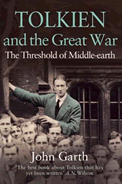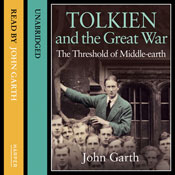John Garth
The Alphabet of Rúmil & Early Noldorin Fragments
Early Qenya & Valmaric
J.R.R. Tolkien
(Parma Eldalamberon 13, 2001, and 14, 2003)
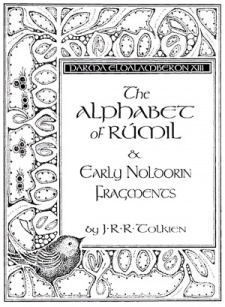 For Tolkien, the word came before the world. Yet his claim that he created Middle-earth to house his invented languages has served mainly to raise sceptical eyebrows. The on-going publication of his writings on the languages and scripts of his sub-created world must remedy this. Parma Eldalamberon, originally a linguistic fanzine, has become the chief vehicle for this more-or-less chronological project (allied to the smaller and more frequent Vinyar Tengwar, which tends to carry substantial items of linguistic interest from later in Tolkien’s life). This material was deemed too complex for inclusion in Christopher Tolkien’s History of Middle-earth.
For Tolkien, the word came before the world. Yet his claim that he created Middle-earth to house his invented languages has served mainly to raise sceptical eyebrows. The on-going publication of his writings on the languages and scripts of his sub-created world must remedy this. Parma Eldalamberon, originally a linguistic fanzine, has become the chief vehicle for this more-or-less chronological project (allied to the smaller and more frequent Vinyar Tengwar, which tends to carry substantial items of linguistic interest from later in Tolkien’s life). This material was deemed too complex for inclusion in Christopher Tolkien’s History of Middle-earth.
The first two instalments of this chronological project presented vocabularies of the two principal interrelated languages as Tolkien originally conceived them: a Gnomish lexicon begun by 1917 and its Qenya counterpart begun in 1915 (Parma Eldalamberon 11: I·Lam na·Ngoldathon and 12: Qenyaqetsa). From these he developed the mythos of the Lost Tales; the stories in turn found their reflection in the lexicons. In the two issues under consideration here, we see how Tolkien developed these languages during the 1920s, while he was turning the original ‘Book of Lost Tales’ into the long ‘Lays of Beleriand’ and the synoptic ‘Silmarillion’.
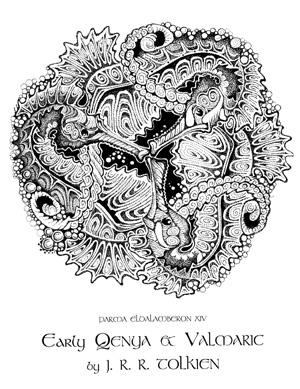 The work Tolkien produced on each language was dictated by the different ways in which he refined them during these years. Tolkien’s Qenya papers reflect his desire to develop a large, elegant system of inflections after the manner of Finnish, the original inspiration for the language. His new grammars complement his earlier Qenya lexicon, and were not replaced until the 1930s. However, in Gnomish or Noldorin (the language he later called Sindarin), Tolkien effected a phonological revolution. He made the consonantal system susceptible to lenition, the ‘softening’ or voicing of sounds; and the vowel system susceptible to umlaut, that is, mutation under the influence of vowels in ensuing syllables (that often later disappeared, as in amon ‘hill’, pl. emyn). It meant that much of the vocabulary he had laid down in the Gnomish lexicon required updating.
The work Tolkien produced on each language was dictated by the different ways in which he refined them during these years. Tolkien’s Qenya papers reflect his desire to develop a large, elegant system of inflections after the manner of Finnish, the original inspiration for the language. His new grammars complement his earlier Qenya lexicon, and were not replaced until the 1930s. However, in Gnomish or Noldorin (the language he later called Sindarin), Tolkien effected a phonological revolution. He made the consonantal system susceptible to lenition, the ‘softening’ or voicing of sounds; and the vowel system susceptible to umlaut, that is, mutation under the influence of vowels in ensuing syllables (that often later disappeared, as in amon ‘hill’, pl. emyn). It meant that much of the vocabulary he had laid down in the Gnomish lexicon required updating.
The effect of such ‘niggling’, as Tolkien characterized it, was much the same in his linguistic creations as it was in his fiction or poetry. None of the items in these journals can be considered finished. Grammars begin confidently with phonology but stop abruptly somewhere en route to syntax; it is fortunate indeed that the early Qenya grammar in manuscript reaches the conjugation of verbs (XIV 56-9). Vocabularies begin as updated collations of earlier vocabularies, but peter out as the alphabet proceeds. To compound the problem, some new phonological innovation would transfix Tolkien part-way through, making redundant many of the forms he had just recorded and prompting him to start afresh with a new word-list: thus we see the arrival of the historical sound-change that yielded p from kw, a phenomenon borrowed from Welsh that swept aside, among others, cweth ‘word’ in favour of peth (XIII 152). Or Tolkien would begin recording cognate words from a new-coined tongue: Old Noldorin and Ilkorin emerge in this way.
| “There is fascination aplenty in this stream of change. It is possible to trace the metamorphosis of an idea over decades” |
The effect is less like a butterfly emerging from a chrysalis than a (rather beautiful) snake shedding its skin over and over again. In The Lord of the Rings, Tolkien’s triumph was to give the illusion of a complete world that, even in a thousand pages, we barely glimpse. On one hand we now see what a vast energy brooded over the hidden details of that world, and the truth behind his Times obituarist’s judgement that he had ‘a Johnsonian horror of going to bed’. But on the other hand Tolkien himself only glimpsed a limited portion of his world; and because he was its creator, what he did not glimpse does not exist. In these fragmentary and protean linguistic writings, there is no sense of perfected completeness.
Words now first appear in forms that would ultimately become familiar to readers of The Lord of the Rings or The Silmarillion: aside from the aforementioned amon, we see ost, nen, aglareb, angren/engrin, amarth, ennyn, narog. But they are rocks deposited by the torrent. A great many of the words here would find no place in Tolkien’s stories, verse, maps and chronologies, where trees, stars and swords loom large but there is little scope for the terminology of dairy-products or sex. (The latter is surprisingly graphic. Does it simply reflect a scientific detachment acquired while working on the taboo-busting Oxford English Dictionary, or are we to understand that the Elves enjoyed a prelapsarian degree of freedom from sexual shame?) Other words are unfamiliar but beautiful, or (far less often) unfamiliar and ugly, such as the transient awfulness of tlub (XIII 154) that briefly displaced celeb ‘silver’. (Galadriel and Tluborn, anyone?) We now see that the Kalevala-inspirednumber word leminkainen meant variously 23 and 50 at different stages, while kainen meant 18, 14 and now 10. In vain does one scutinize the Elvish poetry of Tolkien’s 1931 paper on language invention, ‘A Secret Vice’, hoping they will accord closely with these Qenya grammars: they do not. [It turns out that a further tranche of grammatical revision preceded the 1931 talk; see Parma Eldalamberon 16: Early Elvish Poetry and Pre-Fëanorian Alphabets.] Nor do the Noldorin and Qenya papers tally closely: at this stage Tolkien appears to have carried out bursts of work on one language or the other, but not side by side.
 Hint of things to come: In one early list, Gulum is the Gnomish name of the demiurge of the sea, Ulmo. Like Gollum, it suggests the sound of water gurgling in a spout-hole. Picture © John Howe
Hint of things to come: In one early list, Gulum is the Gnomish name of the demiurge of the sea, Ulmo. Like Gollum, it suggests the sound of water gurgling in a spout-hole. Picture © John Howe
We are also presented with the corpus of two writing systems, Rúmilian and Valmaric, used from 1919 and 1922 respectively until the mid-1920s. They represent part of the sub-creative fiction, being the script in which the Lost Tales were supposed to have been preserved in the Golden Book by Eriol or his son. The first, ascribed to Rúmil, the gnome who appeared to Eriol in the Cottage of Lost Play prattling of his prowess in the speech of birds (Lost Tales I 47), is reminiscent of the Devanagari alphabet which Tolkien would have seen used for Sanskrit; Valmaric is superficially similar to Tolkien’s later, more famous tengwar. One Rúmilian fragment (XIII 88-9), however, reveals how Tolkien not only based some of the tengwar on that script, but characteristically made this influence part of the fictional history of Middle-earth.
Thus there is fascination aplenty in this stream of change. It is possible to trace the metamorphosis of an idea over decades. During the First World War, he glossed the Qenya Kalimban as ‘Germany’, relating it to kalimbo ‘a savage, uncivilized man. — giant, monster, troll’, with clear nationalistic intent (Tolkien and the Great War 128). Now, references to Germany have vanished, and Kalimbo is an alternative name for Gothmog, lord of Balrogs (PE14 12). We see lingering traces of his initial inclination to write himself, his brother Hilary and his wife Edith into the mythology; and early instances of his calendar-craft and heraldry. Tolkien charts a hierarchy of sentient beings in which the natural world is haunted everywhere by fays; the tendency that gave rise to the Ents is even written into his invented grammars, where ‘in Qenya living things as trees etc. are never regarded as neuter’ (PE14 44).
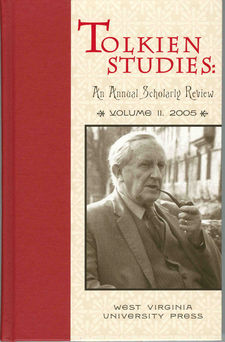 It is tantalizing to witness the emergence of doriath, ivrin and orthanc, each with a significance entirely different to the ones Tolkien later more famously gave them. Gulum, too, hints at things to come: but here in an early name list it is the Gnomish name of the demiurge of the sea, Ulmo (PE13 101). Bearing in mind Sméagol’s origins in Tolkien’s poem ‘Glip’, who sings a ‘gurgling song’ in his sea-cliff cave (Anderson, The Annotated Hobbit 112), we can see that the onomatopoeia of water slapping in a spout-hole may underlie both Gulum and Gollum. As with his narratives, in which the rider who terrified the hobbits in the Shire turned out, in the first draft, to have been Gandalf rather than a Ringwraith (Return of the Shadow 47-8), here Tolkien established the shape before he discovered its enduring significance. We also see him experimenting with the shapes of Rúmilian letters or Noldorin words while making no attempt to assign sounds or meanings to them: a pure exploration of formal possibilities.
It is tantalizing to witness the emergence of doriath, ivrin and orthanc, each with a significance entirely different to the ones Tolkien later more famously gave them. Gulum, too, hints at things to come: but here in an early name list it is the Gnomish name of the demiurge of the sea, Ulmo (PE13 101). Bearing in mind Sméagol’s origins in Tolkien’s poem ‘Glip’, who sings a ‘gurgling song’ in his sea-cliff cave (Anderson, The Annotated Hobbit 112), we can see that the onomatopoeia of water slapping in a spout-hole may underlie both Gulum and Gollum. As with his narratives, in which the rider who terrified the hobbits in the Shire turned out, in the first draft, to have been Gandalf rather than a Ringwraith (Return of the Shadow 47-8), here Tolkien established the shape before he discovered its enduring significance. We also see him experimenting with the shapes of Rúmilian letters or Noldorin words while making no attempt to assign sounds or meanings to them: a pure exploration of formal possibilities.
Here, as in his cosmogonic myth, the Ainulindalë, Tolkien seems to have taken to heart the advice of an old friend. Christopher Wiseman had once told him, ‘The completed work is vanity; the process of the working is everlasting... Just as the fugue is nothing on the page; it is only vital as it works its way out....’ (Tolkien and the Great War 122, 254.) A cynic might say that taking it to heart was the only way to allay a sense of guilt about so vast a quantity of unfinished work. But these records of ever-shifting taste and technique in language and script invention testify to a belief in creativity as process. Such a belief underpins the ‘Silmarillion’, the story of what happens when the arch-sub-creator, Fëanor, attempts perfection. Tolkien’s own view is clear from the fact that Fëanor names his most arrogant and cruel son Cranthir: it means ‘perfect’ (XIII 161).
| “Tolkien’s linguistic inventions are essential to a full view of the growth of his legendarium and greatly enrich an understanding of a phenomenal imagination” |
In Christopher Gilson, Carl F. Hostetter, Arden R. Smith (who focuses on Tolkien’s writing systems), Bill Welden and Patrick Wynne, we are fortunate to have an editorial team whose diligence and attention to detail match Tolkien’s own. This material presents difficulties not only of subject-matter, but also of presentation, but the team has handled the diverse collection of fragments and palimpsests both thoroughly and deftly. Occasionally the air of scholarship sits ill with the subject matter: on deciphering some Noldorin marginalia as a reference to the Byzantine emperor drinking excessively and then eating six houses, it was hardly necessary to add that ‘if that is the correct interpretation it must have been intended humorously’ (XIII 128). But everywhere this intractable material is well marshalled for our better understanding. Tolkien’s many corrections are noted, and often explained, in footnotes. Wordlists are extensively cross-referenced, internally and also against other wordlists; the net is sometimes cast very wide. Etymological interpretations are usually astute, though the limited and shifting corpus makes for hazardous guesswork at times. Judicious explanations are given for a few linguistic terms (epenthesis, proparoxyton). The principal achievement of the editors is to reveal the continuities underlying apparent flux, the pattern behind particular changes. Morphological and phonological rules underlie everything: changes in word shape or sense that at first seem arbitrary usually reflect a refinement of those rules.
Who will read these journals, and their sibling Vinyar Tengwar? There will be those who find clues here to the workings of Tolkien’s creative mind, and those who enjoy in his linguistic inventions for aesthetic or technical reasons. They are, indeed, essential to a full view of the growth of the legendarium and greatly enrich an understanding of a phenomenal imagination. In the massive project of excavating and illuminating his work on the languages and scripts of Middle-earth, there is scope for years of analysis and delight.
• Read my review of Parma Eldalamberon 15.
• The Alphabet of Rúmil is edited by Arden R. Smith; Early Noldorin
Fragments is edited by Christopher Gilson, Bill Welden, Carl F. Hostetter
and Patrick Wynne. Parma Eldalamberon 13 is currently out of print.
• Early Qenya & Valmaric includes Early Qenya Fragments, edited by Patrick Wynne and Christopher Gilson; Early Qenya Grammar, edited by Carl F. Hostetter and Bill Welden; and The Valmaric Script, edited by Arden R. Smith. Order a copy of Parma Eldalamberon 14.
© John Garth 2005. Reproduced with thanks to West Virginia University Press. Ulmo, Lord of Waters reproduced with permission of John Howe.
